
Berycopsis is an extinct genus of marine ray-finned fish from the Late Cretaceous period. Fossils are known from England, Germany, and Lebanon. A potential specimen is known from the Czech Republic.

Cimolichthys is an extinct genus of large predatory marine aulopiform ray-finned fish known worldwide from the Late Cretaceous. It is the only member of the family Cimolichthyidae.
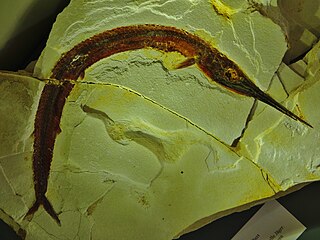
Belonostomus is a genus of prehistoric ray-finned fish that was described by Louis Agassiz in 1844. It is a member of the order Aspidorhynchiformes, a group of fish known for their distinctive elongated rostrums.

Apateodus is a genus of prehistoric marine ray-finned fish which was described by Woodward in 1901. It was a relative of modern lizardfish and lancetfish in the order Aulopiformes, and one of a number of prominent nektonic aulopiforms of Cretaceous marine ecosystems.
Apateopholis is an extinct genus of prehistoric marine ray-finned fish. It is the only member of the family Apateopholidae and contains a single species, A. laniatus, from the Cenomanian of Lebanon. It was a relative of modern lizardfish and lancetfish in the order Aulopiformes. At least one study has found it to be a potential sister genus to the enigmatic Yabrudichthys of the West Bank.

Bananogmius is an extinct genus of marine ray-finned fish that was found in what is now North America and Europe during the Late Cretaceous, from the Cenomanian to the Santonian. It lived in the Western Interior Seaway, which split North America in two during the Late Cretaceous, as well as the proto-North Sea of Europe.

Nursallia is an extinct genus of pycnodontid ray-finned fishes, ranging from the Late Cretaceous period until its extinction during the Eocene.

Aulolepis is an extinct genus of prehistoric marine ray-finned fish that lived from the middle Cenomanian to the late Turonian. It contains a single species, A. typus from the Chalk Group of the United Kingdom and the Hesseltal Formation of Germany.
Ctenocephalichthys is an extinct genus of prehistoric marine ray-finned fish, generally considered a holocentriform, that lived during the Late Cretaceous. It is known from Cenomanian to the Santonian of Lebanon.
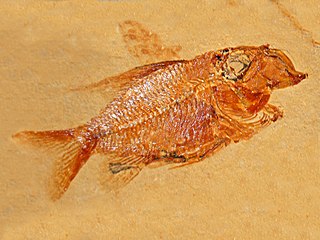
Lissoberyx is an extinct genus of prehistoric ray-finned fish belongon to the family Trachichthyidae. Lissoberyx is a trachichthyid, but it shows more resemblance to the holocentrids than any other trachichthyid.
Barcarenichthys is an extinct genus of prehistoric marine ray-finned fish that lived during the Late Cretaceous. It contains a single species, B. joneti, from the late Cenomanian of Portugal.

Ctenothrissa is a prehistoric genus of marine ray-finned fish in the order Ctenothrissiformes. It contains a number of species known from the Late Cretaceous of England and Lebanon.
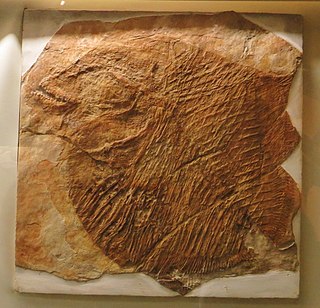
Coelodus is an extinct genus of marine and possibly freshwater pycnodont fish. It contains only one definitive species, C. saturnusHeckel, 1854, from the Late Cretaceous of Slovenia. Other species from the Late Jurassic to the Eocene have also been attributed to this genus based on isolated dental elements, but their assignment to Coelodus is uncertain, and this genus likely represents a non-monophyletic wastebasket taxon. A potential diagnostic trait is a prearticular tooth row with three regular highly elongated teeth.
Clupavus is an extinct genus of marine ray-finned fish that lived during the middle of the Cretaceous period. It is known from North Africa, Europe, Brazil, and possibly North America.

Cylindracanthus is an extinct, enigmatic genus of marine ray-finned fish with fossils known throughout North America, Europe, Asia and Africa from the Late Cretaceous to the late Eocene, with potential Oligocene records and a possible Miocene record also known. It is exclusively known from its distinctive partial remains, which are long cylindrical bony spines that are usually considered rostrum fragments, as well as some associated teeth. These spines are abundant & widespread throughout this timespan, and are useful indicators of a nearshore marine environment, but the taxonomic identity of the fish is still highly uncertain and debated.
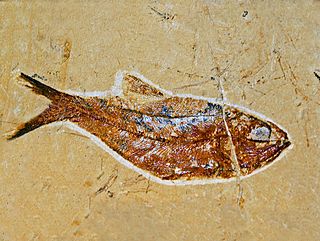
Armigatus is an extinct genus of marine clupeomorph fishes belonging to the order Ellimmichthyiformes. These fishes lived in the Cretaceous ; their fossil remains have been found in Mexico, Europe, the Middle East and North Africa, suggesting the genus ranged across the Tethys Sea.
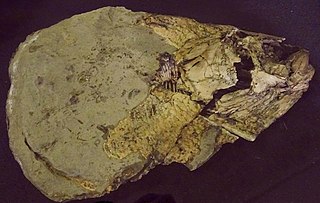
Bachea is an extinct genus of ray-finned fish that lived during the Late Cretaceous in what is now central Colombia, South America. The type species is Bachea huilensis, described in 1997 by María Páramo from the Turonian of Huila, Colombia.

Halecidae is an extinct family of aulopiform ray-finned fish known from the Cretaceous. It is one of the Enchodontoidei, a diverse group of aulopiforms that were dominant marine fish during the Cretaceous.

The Enchodontoidei are an extinct superorder of aulopiform fish known from the Early Cretaceous to the Eocene. They were among the dominant predatory marine fish groups in the Late Cretaceous, achieving a worldwide distribution. They were an extremely diverse group, with some developing fusiform body plans whereas others evolved elongated body plans with long beaks, superficially similar to eels and needlefish. They could also grow to very large sizes, as seen with Cimolichthys and Stratodus, the latter of which is the largest aulopiform known. Their most famous member is the widespread, abundant, and long-lasting genus Enchodus.
Sahel Alma or Sahel Aalma is a Late Cretaceous paleontological site and Konservat-Lagerstätte in Keserwan-Jbeil, Lebanon. Located near the town of the same name, it documents well-preserved deepwater marine fossils dating to the late Santonian stage of the Cretaceous. It is often associated with the slightly older, similarly famous Sannine Formation sites, with these four sites being together referred to as the "Fish Beds" of Lebanon.















